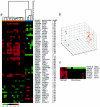Expression profiling of synovial sarcoma by cDNA microarrays: association of ERBB2, IGFBP2, and ELF3 with epithelial differentiation
- PMID: 12414507
- PMCID: PMC1850795
- DOI: 10.1016/S0002-9440(10)64437-9
Expression profiling of synovial sarcoma by cDNA microarrays: association of ERBB2, IGFBP2, and ELF3 with epithelial differentiation
Abstract
Synovial sarcoma is an aggressive spindle cell sarcoma with two major histological subtypes, biphasic and monophasic, defined respectively by the presence or absence of areas of glandular epithelial differentiation. It is characterized by a specific chromosomal translocation, t(X;18)(p11.2;q11.2), which juxtaposes the SYT gene on chromosome 18 to either the SSX1 or the SSX2 gene on chromosome X. The chimeric SYT-SSX products are thought to function as transcriptional proteins that deregulate gene expression, thereby providing a putative oncogenic stimulus. We investigated the pattern of gene expression in synovial sarcoma using cDNA microarrays containing 6548 sequence-verified human cDNAs. A tissue microarray containing 37 synovial sarcoma samples verified to bear the SYT-SSX fusion was constructed for complementary analyses. Gene expression analyses were performed on individual tumor samples; 14 synovial sarcomas, 4 malignant fibrous histiocytomas, and 1 fibrosarcoma. Statistical analysis showed a distinct expression profile for the group of synovial sarcomas as compared to the other soft tissue sarcomas, which included variably high expression of ERBB2, IGFBP2, and IGF2 in the synovial sarcomas. Immunohistochemical analysis of protein expression in tissue microarrays of 37 synovial sarcomas demonstrated strong expression of ERBB2 and IGFBP2 in the glandular epithelial component of biphasic tumors and in solid epithelioid areas of some monophasic tumors. Fluorescence in situ hybridization analysis indicated that the ERBB2 overexpression was not because of gene amplification. Differentially expressed genes were also found in a comparison of the expression profiles of the biphasic and monophasic histological subgroups of synovial sarcoma, notably several keratin genes, and ELF3, an epithelial-specific transcription factor gene. Finally, we also noted differential overexpression of several neural- or neuroectodermal-associated genes in synovial sarcomas relative to the comparison sarcoma group, including OLFM1, TLE2, CNTNAP1, and DRPLA. Our high-throughput studies of gene expression patterns, complemented by tissue microarray studies, confirm the distinctive expression profile of synovial sarcoma, provide leads for the study of glandular morphogenesis in this tumor, and identify a new potential therapeutic target, ERBB2, in a subset of cases.
Figures


Comment in
-
Gene expression studies on soft tissue tumors.Am J Pathol. 2002 Nov;161(5):1531-4. doi: 10.1016/S0002-9440(10)64430-6. Am J Pathol. 2002. PMID: 12414500 Free PMC article. No abstract available.
References
-
- Lewis JJ, Antonescu CR, Leung DH, Blumberg D, Healey JH, Woodruff JM, Brennan MF: Synovial sarcoma: a multivariate analysis of prognostic factors in 112 patients with primary localized tumors of the extremity. J Clin Oncol 2000, 18:2087-2094 - PubMed
-
- Spillane AJ, A’Hern R, Judson IR, Fisher C, Thomas JM: Synovial sarcoma: a clinicopathologic, staging, and prognostic assessment. J Clin Oncol 2000, 18:3794-3803 - PubMed
-
- Trassard M, Le DV, Hacene K, Terrier P, Ranchere D, Guillou L, Fiche M, Collin F, Vilain MO, Bertrand G, Jacquemier J, Sastre-Garau X, Bui NB, Bonichon F, Coindre JM: Prognostic factors in localized primary synovial sarcoma: a multicenter study of 128 adult patients. J Clin Oncol 2001, 19:525-534 - PubMed
-
- Rosen G, Forscher C, Lowenbraun S, Eilber F, Eckardt J, Holmes C, Fu YS: Synovial sarcoma: uniform response of metastases to high dose ifosfamide. Cancer 1994, 73:2506-2511 - PubMed
-
- Clark J, Rocques PJ, Crew AJ, Gill S, Shipley J, Chan AML, Gusterson BA, Cooper CS: Identification of novel genes, SYT and SSX, involved in t(X;18)(p112;q112) translocation found in human synovial sarcoma. Nat Genet 1994, 7:502-508 - PubMed
Publication types
MeSH terms
Substances
Grants and funding
LinkOut - more resources
Full Text Sources
Other Literature Sources
Medical
Research Materials
Miscellaneous

